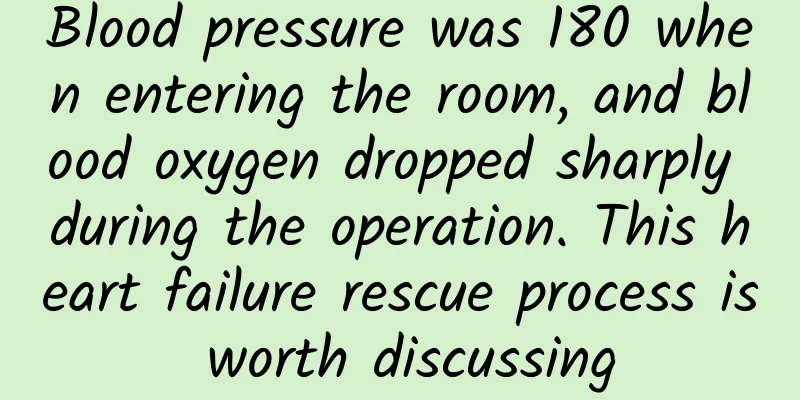Blood pressure was 180 when entering the room, and blood oxygen dropped sharply during the operation. This heart failure rescue process is worth discussing

|
Anesthesia work is like walking a tightrope every day. With artificial airways and controlled ventilation, anesthesiologists can generally handle situations calmly. However, there are some situations that can make anesthesiologists break out in a cold sweat. A serious incident occurred during an anesthesia operation not long ago. I still feel scared when I think about it. A 65-year-old male patient weighing 80 kg was undergoing TURP due to prostate hypertrophy and dysuria. Preoperative examination revealed that the patient's heart function was in Class II, and he had a history of hypertension and coronary heart disease for more than 20 years. With long-term medication control, his blood pressure was still normal, and his coronary heart disease was relatively stable. However, despite taking antihypertensive drugs before the operation, the patient's blood pressure still rose when he entered the operating room. The blood pressure was 181/96 mm Hg, the heart rate was 72 beats/min, and the pulse SpO2 was 97%. Considering that the patient was nervous due to the surgery, midazolam 3 mg was given for appropriate sedation, and the blood pressure dropped to 140/75 mm Hg. After adequate oxygen inhalation, anesthesia induction was performed. During the induction process, blood pressure once dropped to 80/50 mm Hg. After treatment with vasoactive drugs, blood pressure stabilized at around 120. 90 minutes into the operation, the patient's blood pressure suddenly dropped to 60/35 mm Hg, blood oxygen saturation dropped to 76%, and heart rate rose to 156 beats/min. Immediately check the ventilation status and auscultate both lungs. Auscultation revealed that the breath sounds were slightly coarse, but there were no bubbling sounds. Careful observation revealed that the patient's lips were dark in color. The nurse calculated that the amount of irrigation fluid used was about 7000 ml, and it was considered to be water intoxication combined with left heart failure. The oxygen flow was increased immediately to correct the hypoxic state. Ephedrine and phenylephrine were injected intravenously in divided doses to increase blood pressure, and 40 mg of methylprednisolone was given to reduce cerebral edema. After 10 minutes, the blood pressure slowly rose to 95/60 mm Hg, followed by continuous dopamine infusion. During this period, the heart rate was maintained at 130-140, with no signs of decline. 0.4 mg of cedilanidate and 20 mg of esmolol were injected intravenously in divided doses. At the same time, 20 mg of furosemide was given to protect renal function. After blood pressure, cardiotonic and diuretic rescue, the patient's vital signs stabilized after half an hour. During the period, blood gas was checked, K3.21mmol/L, Na 134.2mmol/L, Cl 98.3mmol/L, PaO2 65.3mmHg, PaCO2 40.7mmHg, SaO2 91.5%, HCO3-22.6mmol/L, blood sugar 18mmol/L. 20 units of insulin were given to adjust blood sugar, and KCl1g was given to supplement potassium. One hour after the operation, vasoactive drugs were gradually reduced, and all drugs were stopped after 2 hours, and the patient was successfully extubated. The lesson from this case is that when an intubated patient suddenly experiences a drop in blood oxygen, the cause needs to be identified and corrected immediately. When it is determined that there is no ventilation problem, if there is no massive blood loss or extremely low blood pressure, the patient's ventilation problem should be considered immediately. If there is a problem with pulmonary ventilation during a surgery that may cause pulmonary edema or pulmonary embolism, a problem with the lungs should be highly suspected. Once there is a problem with the lungs, the cause should be addressed immediately. In this case, a large amount of lavage fluid was administered during the operation, and the preoperative hypertension and coronary heart disease made it very likely that pulmonary edema and heart failure occurred. Therefore, volume overload and heart failure should be actively corrected. During the treatment, continuous dopamine infusion maintains blood pressure, which can ensure adequate blood perfusion to the kidneys and surrounding tissues, dilate renal blood vessels, and increase glomerular filtration rate. Using digitalis and beta-blockers and controlling fluid intake are beneficial to the improvement of heart failure. In addition, pay attention to the eyelids. If signs of cerebral edema occur, dehydration therapy and glucocorticoids should be given to reduce intracranial pressure. Finally, we raise a question: Some people say that when elderly patients with comorbidities undergo TURP, spinal anesthesia should be given priority to keep the patient awake as much as possible. Once symptoms such as irritability, shortness of breath, and impaired consciousness appear, problems can be discovered early. So, what do you think? [Warm Tips] Follow us, there are a lot of professional medical knowledge here, revealing the secrets of surgical anesthesia for you~ |
<<: 【Health Lecture】One article will help you understand arrhythmia
Recommend
What to do if you have no appetite during pregnancy
Loss of appetite in the second trimester is a sym...
What should I do if the egg matures but is not released?
If a woman's eggs mature but are not released...
What are the adverse effects of thin uterine wall?
The phenomenon of thin uterine wall will have a g...
Directly attacking the three major solid tumors! Chinese scientists released a deep learning system to be more confident in dealing with the "world's number one killer"!
A report released by the World Health Organizatio...
Female vaginal signs
Women's organs are very unique. Just like peo...
How can I relieve rough and sagging skin?
I believe that many girls with bad skin envy babi...
Why did my mouth become crooked after a nap?
60-year-old Mr. Wang slept with the window open. ...
Why does the body temperature not rise after ovulation?
For normal women of childbearing age, their basal...
How many days after menstruation can I have sex? Tell you the right way
As we all know, women cannot have sex during mens...
What does ovulation leucorrhea look like?
The female reproductive system will produce secre...
Why does ectopic pregnancy occur?
In a normal pregnancy, the sperm and egg combine ...
When is the best time for children with ventricular septal defect to undergo surgery? What should be paid attention to after the operation?
Author: Lv Zhenyu, deputy chief physician, Beijin...
Academician's cancer prevention advice: the top priorities for cancer prevention
Text: Sun Yan, Cancer Hospital, Chinese Academy o...
How do pubic lice arise?
There are many diseases that threaten people'...









